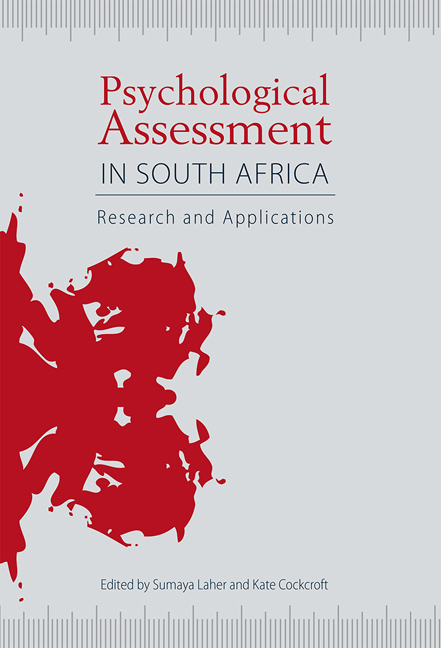Book contents
- Frontmatter
- Contents
- Tables and figures
- Acknowledgements
- Acronyms and abbreviations
- 1 Contextualising psychological assessment in South Africa
- Section One Cognitive tests: conceptual and practical applications
- Section Two Personality and projective tests: conceptual and practical applications
- 14 The Sixteen Personality Factor Questionnaire in South Africa
- 15 Using the Fifteen Factor Questionnaire Plus in South Africa
- 16 The Basic Traits Inventory
- 17 The Myers-Briggs Type Indicator® in South Africa
- 18 The NEO-PI-R in South Africa
- 19 Using the Occupational Personality Profile in South Africa
- 20 The Occupational Personality Questionnaire
- 21 The Millon Inventories in South Africa
- 22 Assessment and monitoring of symptoms in the treatment of psychological problems
- 23 Assessment in routine clinical and counselling settings
- 24 Projective assessment of adults and children in South Africa
- 25 The use of the Children's Apperception Test and Thematic Apperception Test in South Africa
- 26 Projective assessment using the Draw-A-Person Test and Kinetic Family Drawing in South Africa
- 27 The Rorschach in South Africa
- Section Three Assessment approaches and methodologies
- Contributors
- Index
26 - Projective assessment using the Draw-A-Person Test and Kinetic Family Drawing in South Africa
from Section Two - Personality and projective tests: conceptual and practical applications
Published online by Cambridge University Press: 21 April 2018
- Frontmatter
- Contents
- Tables and figures
- Acknowledgements
- Acronyms and abbreviations
- 1 Contextualising psychological assessment in South Africa
- Section One Cognitive tests: conceptual and practical applications
- Section Two Personality and projective tests: conceptual and practical applications
- 14 The Sixteen Personality Factor Questionnaire in South Africa
- 15 Using the Fifteen Factor Questionnaire Plus in South Africa
- 16 The Basic Traits Inventory
- 17 The Myers-Briggs Type Indicator® in South Africa
- 18 The NEO-PI-R in South Africa
- 19 Using the Occupational Personality Profile in South Africa
- 20 The Occupational Personality Questionnaire
- 21 The Millon Inventories in South Africa
- 22 Assessment and monitoring of symptoms in the treatment of psychological problems
- 23 Assessment in routine clinical and counselling settings
- 24 Projective assessment of adults and children in South Africa
- 25 The use of the Children's Apperception Test and Thematic Apperception Test in South Africa
- 26 Projective assessment using the Draw-A-Person Test and Kinetic Family Drawing in South Africa
- 27 The Rorschach in South Africa
- Section Three Assessment approaches and methodologies
- Contributors
- Index
Summary
Interest in human figure drawings and their evaluation dates back to the 18th century. Drawings are considered to serve as projective techniques, as they present individuals with an unstructured and ambiguous situation, inviting them to make meaning of these tasks by drawing on their own life experiences. This allows for the exploration of a rich tapestry of material which depicts their inner world, emotions, perceptions, personality, needs and interpretation of reality (Zubin, Eron & Schumer, 1965) which may not be possible through direct communication (Machover, 1949/1980). The use of projective techniques is based on the assumption that the individual is driven by psychological forces blocked from consciousness. Unconscious conflicts are revealed by the projection of the individual's characteristic modes of response, thought processes, impulses, needs and anxieties onto the unstructured projective task. Projection is commonly regarded as the general tendency to externalise aspects of the self (Rabin, 1981).
According to Machover (1949/1980), the human figure drawing can be understood to be the way the individual projects his inner reality of past experience and current moods, tensions and concerns by the symbolism of his body image. This inner reality is the self-concept. The psychoanalytic view holds that there are both conscious and unconscious aspects of the self, and it is the unconscious expression of conflicts, body image, self and the environment as well as sexual identity which is projected in drawings (Furth, 1988; Hammer, 1997; Koppitz, 1968). Kanchan, Khan, Singh, Jahan and Sengar (2010) point out that projection of the self should not be defined in narrow terms, as it includes not only the individual's actual self but also the ideal self and the feared self. The theoretical concepts that underlie projective assessment are discussed more fully in chapter 24 of this volume.
Despite the ongoing controversy surrounding projective drawing tests (Matto & Naglieri, 2005; Roback, 1968; Swensen, 1968; Williams, Fall, Eaves & Woods-Groves, 2006), human figure drawings remain among the most widely used psychological tests by clinicians (Camara, Nathan & Puente, 2000). The Draw-A-Person (DAP) Test is rated among the top 10 to 15 most frequently used projective tests abroad (Hojnoski, Morrison, Brown & Matthews, 2006; Yama, 1990) and a similar rating is given for the popularity of the DAP and the Kinetic Family Drawing (KFD) amongst South African practitioners (Foxcroft, Paterson, Le Roux & Herbst, 2004).
- Type
- Chapter
- Information
- Psychological Assessment in South AfricaResearch and Applications, pp. 375 - 393Publisher: Wits University PressPrint publication year: 2013



